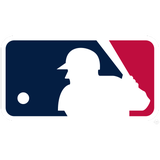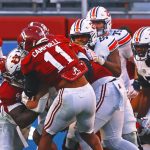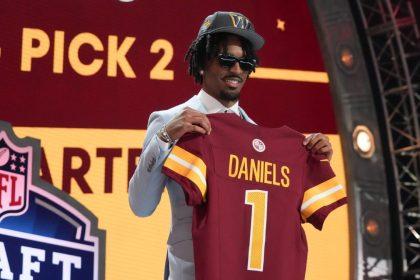Climate change is making major league sluggers into even hotter hitters, sending an extra 50 or so home runs a year over the fences, a new study found.
Hotter, thinner air that allows balls to fly farther contributed a tiny bit to a surge in home runs since 2010, according to a statistical analysis by Dartmouth College scientists published in Friday’s Bulletin of the American Meteorological Society. They analyzed 100,000 MLB games and more than 200,000 balls put into play in the last few years along with weather conditions, stadiums and other factors.
“Global warming is juicing home runs in Major League Baseball,” said study coauthor Justin Mankin, a Dartmouth climate scientist.
It’s basic physics.
When air heats up, molecules move faster and away from each other, making the air less dense. Baseballs launched off a bat go farther through thinner air because there’s less resistance to slow the ball. Just a little bit farther can mean the difference between a homer and a flyout, said Alan Nathan, a University of Illinois physicist who wasn’t part of the Dartmouth study.
Nathan, one of a group of scientists who has consulted with Major League Baseball on the increase in homers, did his own simple calculation, based purely on known physics of ballistics and air density as it changes with temperature, and said he got the same result as the Dartmouth researchers.
Both Nathan and the Dartmouth team found a 1% increase in home run likelihood with every degree the air warms (1.8% with each degree Celsius). Total yearly average of warming-aided homers is only 1% of all home runs hit, the Dartmouth researchers calculated.
ADVERTISEMENT
Non-climate factors contribute even more to the barrage of balls flying out of the park, scientists and baseball veterans said. The biggest is the ball and the size of the stitches, Nathan said, and MLB made slight adjustments to deaden the ball prior to the 2021 season. Others include batters’ recent attention to launch angle; stronger hitters; and faster pitches. The study started after the end of baseball’s infamous steroids era saw a spike in home runs.
Veteran baseball players and executives said the research fits with what they’ve seen on the field.
“We always felt that way for years,” Phillies president of baseball operations Dave Dombrowski said. “When it’s warmer, the ball travels more, and they have scientific evidence to back that up.”
Homers have always varied by ballpark due to simple factors like dimensions that are friendlier to pitchers than hitters, or vice versa, as well as wind conditions.
The Dartmouth team found the climate homer effect varied by field, too. Chicago’s Wrigley Field, which still hosts a lot of day games, has the most warming-homer friendly confines. The statistical analysis found no significant heat-aided homers at Tampa’s Tropicana Field, the only full-time domed stadium in Major League Baseball.
“It’s interesting to think about,” said five-time All-Star pitcher David Cone, who once threw a perfect game and is now a television baseball analyst. “I’d probably more likely look at the makeup of the baseball itself, the variances and the specs. Of course, weather matters, definitely I wouldn’t shoo it away.”
After a 1-0 victory in Coors Field, Colorado Rockies reliever Brent Suter said the study, which mentions more than 500 home runs since 2010, rings true to him.
“Obviously I’m not a fan in any way as a pitcher,” Suter said with a laugh. “500 seems a lot, but I could believe it.”
The heat is also hard on players and fans, Suter said. “I remember pitching some games I was just, like ‘This does not feel like normal heat. It’s crazy hot.’”
The average U.S. temperature in June, July and August has increased by more than 2 degrees (1.1 degrees Celsius) in the last 40 years, according to the National Oceanic and Atmospheric Administration.
Mankin called what’s happening “a fingerprint of climate change on our recreation.” Callahan said what’s been seen so far is nothing compared to projections of hundreds of extra homers in the future.
How many extra homers depends on how hot it gets, which depends on how much greenhouse gas the world spews from the burning of coal, oil and gas. Callahan ran different scenarios of carbon pollution through computer simulations.
In the worst-case warming trajectory — which some scientists say the world is no longer on based on recent emissions — there would be about 192 warming-aided homers a year by 2050 and around 467 hot home runs by the year 2100. In more moderate carbon pollution scenarios, closer to where Earth is now tracking, there would be about 155 warming-aided homers a year by 2050 and around 255 extra dingers at the end of the century, Callahan said.
Because baseball has so many statistics and analytics, such as the tracking system Statcast, trends can be seen more easily than other effects of climate change, Mankin said. Still, the scientists can’t point to a single homer and say that’s a warming-aided home run. It’s a detail that can be only seen in the more than 63,000 homers hit since 2010.
Several climate scientists told The Associated Press that the study makes perfect sense and the statistics are analyzed properly, though they also point out factors other than climate change are in play and likely have bigger effects.
Both Texas A&M’s Andrew Dessler and University of Illinois’ Don Wuebbles said while the rise in home runs is interesting, it pales next to the issues of extreme weather and rising seas.
But Callahan said it actually brings home the threat of climate change in a unique way. Besides resulting in more home runs, a warming climate will likely require more domed stadiums because it will simply be too hot outside for humans in some places.
“Global warming is going to reshape so many of the things that we care about in so many pernicious and subtle ways,” Callahan said. “And the fact that we’ll get to go to fewer baseball games played in open air is not a civilization-ending crisis, but it is another sign of the way that we have reshaped our lives due to our greenhouse gas emissions.”
Reporting by The Associated Press.
Read more:
MLB trending

Get more from Major League Baseball Follow your favorites to get information about games, news and more












